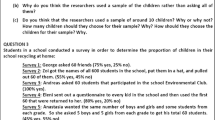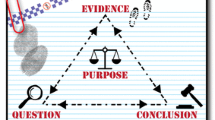Abstract
This study situates children's early notions of average within an inquiry classroom to investigate the rich inferential reasoning that young children drew on to make sense of the questions: Is there a typical height for a student in year 3? If so, what is it? Based on their deliberations over several lessons, students' ideas about average and typicality evolved as meaning reasonable, contrary to atypical, most common (value or interval), middle, normative, and representative of the population. The case study reported here documents a new direction for the development of children's conceptions of average in a classroom designed to elicit their informal inferential reasoning about data.

Similar content being viewed by others
References
Ainley, J., Pratt, D., & Nardi, E. (2001). Normalising: Children's activity to construct meanings for trend. Educational Studies in Mathematics, 45, 131–146.
Allmond, S., Wells, J., & Makar, K. (2010). Thinking through mathematics: Engaging students with inquiry-based learning (Books 1-3). Melbourne: Curriculum Press.
Bakker, A. (2004). Reasoning about shape as a pattern in variability. Statistics Education Research Journal, 3, 64–83.
Bakker, A., & Derry, J. (2011). Lessons from inferentialism for statistics education. Mathematical Thinking and Learning, 13, 5–26.
Ben-Zvi, D., Aridor, K., Makar, K., & Bakker, A. (2012). Students' emergent articulations of uncertainty while making informal statistical inferences. ZDM—The International Journal on Mathematics Education (Zentralblatt für Didaktik der Mathematik), 44, 913–925.
Ben-Zvi, D., Gil, E., & Apel, N. (2007, August). What is hidden beyond the data? Young students reason and argue about some wider universe. Paper presented at the Fifth International Forum for Research on Statistical Reasoning, Thinking and Literacy, University of Warwick, UK.
Cobb, P. (1999). Individual and collective mathematical development: The case of statistical data analysis. Mathematical Thinking and Learning, 1, 5–43.
Cobb, P., Confrey, J., diSessa, A. A., Lehrer, R., & Schauble, L. (2003). Design experiments in educational research. Educational Researcher, 32, 9–13.
Dewey, J. (1938). Logic: The theory of inquiry. New York: Henry Holt & Company.
Dierdorp, A., Bakker, A., Eijkelhof, H., & van Maanen, J. (2011). Authentic practices as contexts for learning to draw inferences beyond correlated data. Mathematical Thinking and Learning, 13, 132–151.
Flick, U. (2009). Introduction to qualitative research (4th ed.). Thousand Oaks, CA: Sage Publications.
Friel, S. N., O’Connor, W., & Mamer, J. D. (2006). More than “Meanmedianmode” and a bar graph: What’s needed to have a statistical conversation. Thinking and reasoning with data and chance: Sixty-eighth NCTM yearbook (pp.117-137). Reston. VA: NCTM.
Gal, I. (2002). Adults' statistical literacy: Meanings, components, responsibilities. International Statistical Review, 70, 1–25.
Ginat, D., & Wolfson, M. (2002). On limited views of the mean as point of balance. Paper presented at the 26th annual conference of the International Group for the Psychology of Mathematics Education. Norwich, UK: University of East Anglia.
Gould, R. (2011). Informal reasoning for informal samples: Statistics in the modern world. Paper presented at the Seventh International Forum for Research on Statistical Reasoning, Thinking and Literacy (SRTL7). Texel, The Netherlands: SRTL.
Harel, G., & Koichu, B. (2010). An operational definition of learning. Journal of Mathematical Behavior, 29, 115–124.
Konold, C., Higgins, T., Russell, S.J., & Khalil, K. (2004). Data Seen through Different Lenses. Unpublished manuscript. http://srri.umass.edu/files/konold-2004dst.pdf, Accessed 9 March 2009.
Konold, C., & Pollatsek, A. (2002). Data analysis as the search for signals in noisy processes. Journal for Research in Mathematics Education, 33, 259–289.
Konold, C., Robinson, A., Khalil, K., Pollatsek, A., Well, A., Wing, R., et al. (2002). Students' use of modal clumps to summarize data. In B. Phillips (Eds.), Developing a statistically literate society. Proceedings of the Sixth International Confere nce on Teaching Statistics. Voorburg: International Association for Statistical Education. The paper is available at http://iase-web.org/documents/papers/icots6/8b2_kono.pdf
Lampen, C. E. (2013). Learning to teach statistics meaningfully. Unpublished doctoral dissertation, University of Witwatersrand, South Africa.
Lavigne, N., & Lajoie, S. (2007). Statistical reasoning of middle school children engaged in survey inquiry. Contemporary Educational Psychology, 32, 630–666.
Makar, K. (2011). Learning over time: Pedagogical change in teaching mathematical inquiry. In Julie Clark, Barry Kissane, Judith Mousley, Toby Spencer & Steve Thornton (Eds.), Mathematics: Traditions and [New] Practices (pp. 25-37) (Proceedings of the 34th annual conference of the Mathematics Education Research Group of Australasia and the Australian Association of Mathematics Teachers). Adelaide: AAMT and MERGA. http://www.merga.net.au/publications/counter.php?pub=pub_conf&id=1642
Makar, K., Bakker, A., & Ben-Zvi, D. (2011). The reasoning behind informal statistical inference. Mathematical Thinking and Learning, 13, 152–173.
Makar, K., & Ben-Zvi, D. (2011). Editorial: The role of context in developing reasoning about informal statistical inference. Mathematical Thinking and Learning, 13, 1–4.
Makar, K., & Fielding-Wells, J. (2011). Teaching teachers to teach statistical investigations. In C. Batanero et al. (Eds.), Teaching statistics in school mathematics. Challenges for teaching and teacher education (pp. 347-358). New York: Springer.
Makar, K., & Rubin, A. (2009). A framework for thinking about informal statistical inference. Statistics Education Research Journal, 8, 82–105.
McGowen, M. A., & Tall, D. O. (2010). Metaphor or met-before? The effects of previous experience on practice and theory of learning mathematics. Journal of Mathematical Behavior, 29, 169–179.
Mercer, N. (2010). The analysis of classroom talk: Methods and methodologies. British Journal of Educational Psychology, 80, 1–14.
Mokros, J., & Russell, S. J. (1995). Children's concept of average and representativeness. Journal for Research in Mathematics Education, 26, 20–39.
Paparistodemou, E., & Meletiou-Mavrotheris, M. (2008). Developing young students' informal inference skills in data analysis. Statistics Education Research Journal, 7, 83–106.
Pfannkuch, M. (2005). Probability and statistical inference: How can teachers enable learners to make the connection? In G. Jones (Ed.), Exploring probability in school: Challenges for teaching and learning (pp. 267–294). Dordrecht: Kluwer Academic Publishers.
Pfannkuch, M. (2006). Informal inferential reasoning. In A. Rossman & B. Chance (Eds.), Working Cooperatively in Statistics Education. Proceedings of the Seventh International Conference on Teaching Statistics. Voorburg: International Statistical Institute. http://iaseweb.org/documents/papers/icots7/6A2_PFAN.pdf
Pratt, D., & Ainley, J. (2008). Introducing the special issue on informal inferential reasoning. Statistics Education Research Journal, 7, 3–4.
Reitman, W. (1965). Cognition and thought: An information-processing approach. New York: Wiley.
Roth, W.-M. (1995). From “wiggly structures” to “unshaky towers”: Problem framing, solution finding, and negotiation of courses of actions during a civil engineering unit for elementary students. Research in Science Education, 25, 365–381.
Rubin, A. (2005). Math that matters: The case for replacing the algebra/calculus track with data literacy—a critical skill for modern life. Threshold Magazine: Exploring the Threshold of Education, Spring 2005 issue, 22-25, 31.
Rubin, A., Bruce, B., & Tenney, Y. (1990, April). Learning about sampling: Trouble at the core of statistics. Paper presented at the annual meeting of the American Educational Research Association, Boston, MA.
Rubin, A., Hammerman, J., & Konold, C. (2006). Exploring informal inference with interactive visualisation software. In A. Rossman & B. Chance (Eds.), Working Cooperatively in Statistics Education. Proceedings of the Seventh International Conference on Teaching Statistics. Voorburg: International Statistical Institute. http://iaseweb.org/documents/papers/icots7/2D3_RUBI.pdf
Scardamalia, M., & Bereiter, C. (2006). Knowledge building: Theory, pedagogy, and technology. In K. Sawyer (Ed.), The Cambridge handbook of the learning sciences (pp. 97-115). Cambridge: Cambridge University Press.
Shaughnessy, J. M. (2007). Research on statistics learning and reasoning. In F. K. Lester (Ed.), Second handbook of research on mathematics teaching and learning (Vol 1, pp. 957-1009). Greenwich, CT: Information Age Publishing and NCTM.
Watson, J. (2006). Statistical literacy at school: Growth and goals. Mahwah NJ: Lawrence Erlbaum.
Watson, J. (2007). The role of cognitive conflict in developing students' understanding of average. Educational Studies in Mathematics, 65, 21–47.
Watson, J., & Moritz, J. (1999). The beginning of statistical inference: Comparing two datasets. Educational Studies in Mathematics, 37, 145–168.
Wild, C., & Pfannkuch, M. (1999). Statistical thinking in empirical enquiry. International Statistical Review, 67, 223–265.
Wolfe, C. R., Reyna, V. F., & Brainerd. C. J. (2005). Fuzzy-trace theory: Implications for transfer in teaching and learning. In J. P. Mestre (Ed.), Transfer of learning from a modern multidisciplinary perspective (pp. 53-87). Greenwich, CT: Information Age Publishing.
Acknowledgments
This study was funded by the Australian Research Council (LP0776703), Education Queensland and The University of Queensland. An abbreviated version of these data were presented at the 2009 annual conference of the Mathematics Education Research Group of Australasia. The author thanks Debra McPhee for her insightful teaching and collaboration on the MERGA version of this paper. Note that the children whose work appears in this paper own their IP.
Author information
Authors and Affiliations
Corresponding author
Rights and permissions
About this article
Cite this article
Makar, K. Young children's explorations of average through informal inferential reasoning. Educ Stud Math 86, 61–78 (2014). https://doi.org/10.1007/s10649-013-9526-y
Published:
Issue Date:
DOI: https://doi.org/10.1007/s10649-013-9526-y




